cooling JEEP RENEGADE 2015 1.G User Guide
[x] Cancel search | Manufacturer: JEEP, Model Year: 2015, Model line: RENEGADE, Model: JEEP RENEGADE 2015 1.GPages: 220, PDF Size: 34.11 MB
Page 161 of 220
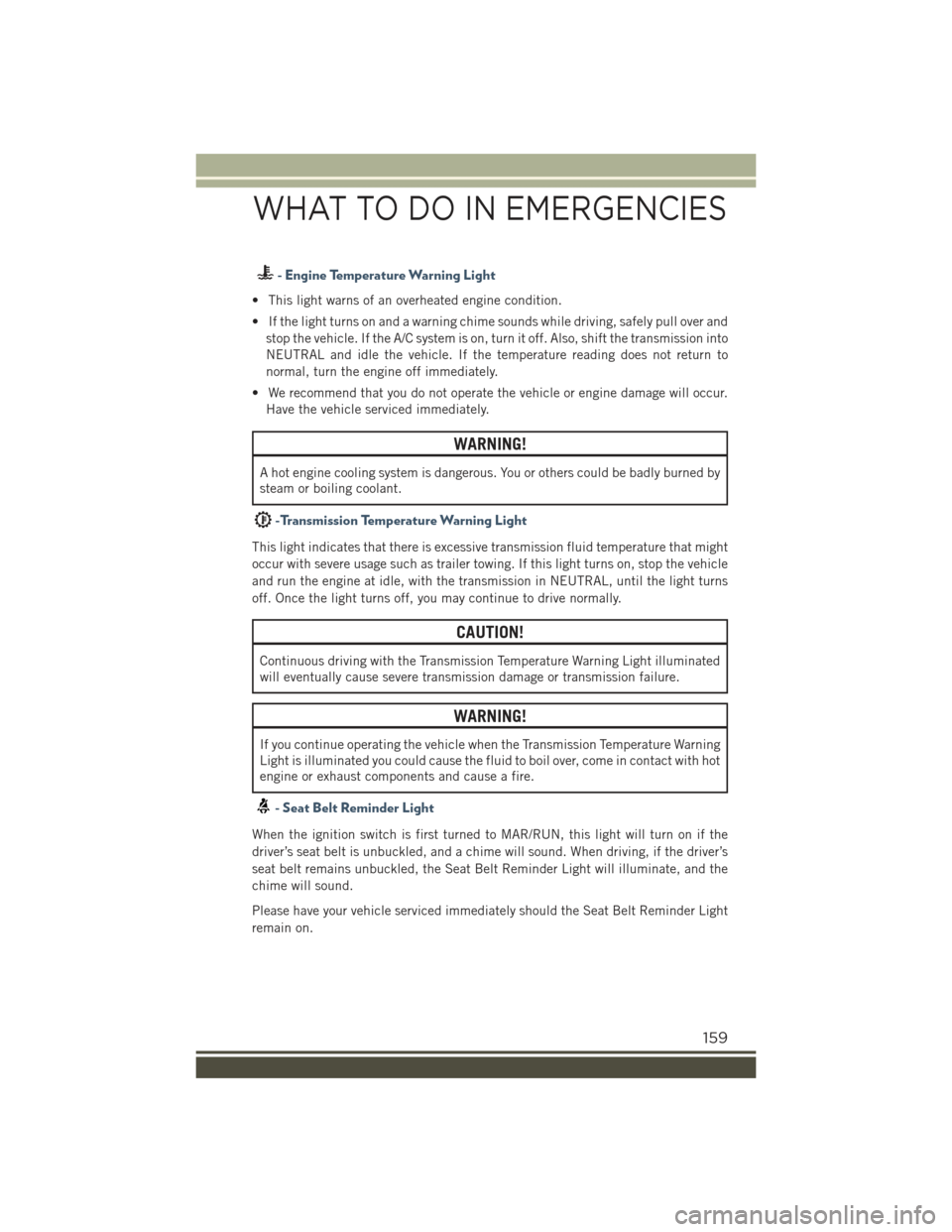
- Engine Temperature Warning Light
• This light warns of an overheated engine condition.
• If the light turns on and a warning chime sounds while driving, safely pull over and
stop the vehicle. If the A/C system is on, turn it off. Also, shift the transmission into
NEUTRAL and idle the vehicle. If the temperature reading does not return to
normal, turn the engine off immediately.
• We recommend that you do not operate the vehicle or engine damage will occur.
Have the vehicle serviced immediately.
WARNING!
A hot engine cooling system is dangerous. You or others could be badly burned by
steam or boiling coolant.
-Transmission Temperature Warning Light
This light indicates that there is excessive transmission fluid temperature that might
occur with severe usage such as trailer towing. If this light turns on, stop the vehicle
and run the engine at idle, with the transmission in NEUTRAL, until the light turns
off. Once the light turns off, you may continue to drive normally.
CAUTION!
Continuous driving with the Transmission Temperature Warning Light illuminated
will eventually cause severe transmission damage or transmission failure.
WARNING!
If you continue operating the vehicle when the Transmission Temperature Warning
Light is illuminated you could cause the fluid to boil over, come in contact with hot
engine or exhaust components and cause a fire.
- Seat Belt Reminder Light
When the ignition switch is first turned to MAR/RUN, this light will turn on if the
driver’s seat belt is unbuckled, and a chime will sound. When driving, if the driver’s
seat belt remains unbuckled, the Seat Belt Reminder Light will illuminate, and the
chime will sound.
Please have your vehicle serviced immediately should the Seat Belt Reminder Light
remain on.
WHAT TO DO IN EMERGENCIES
159
Page 166 of 220
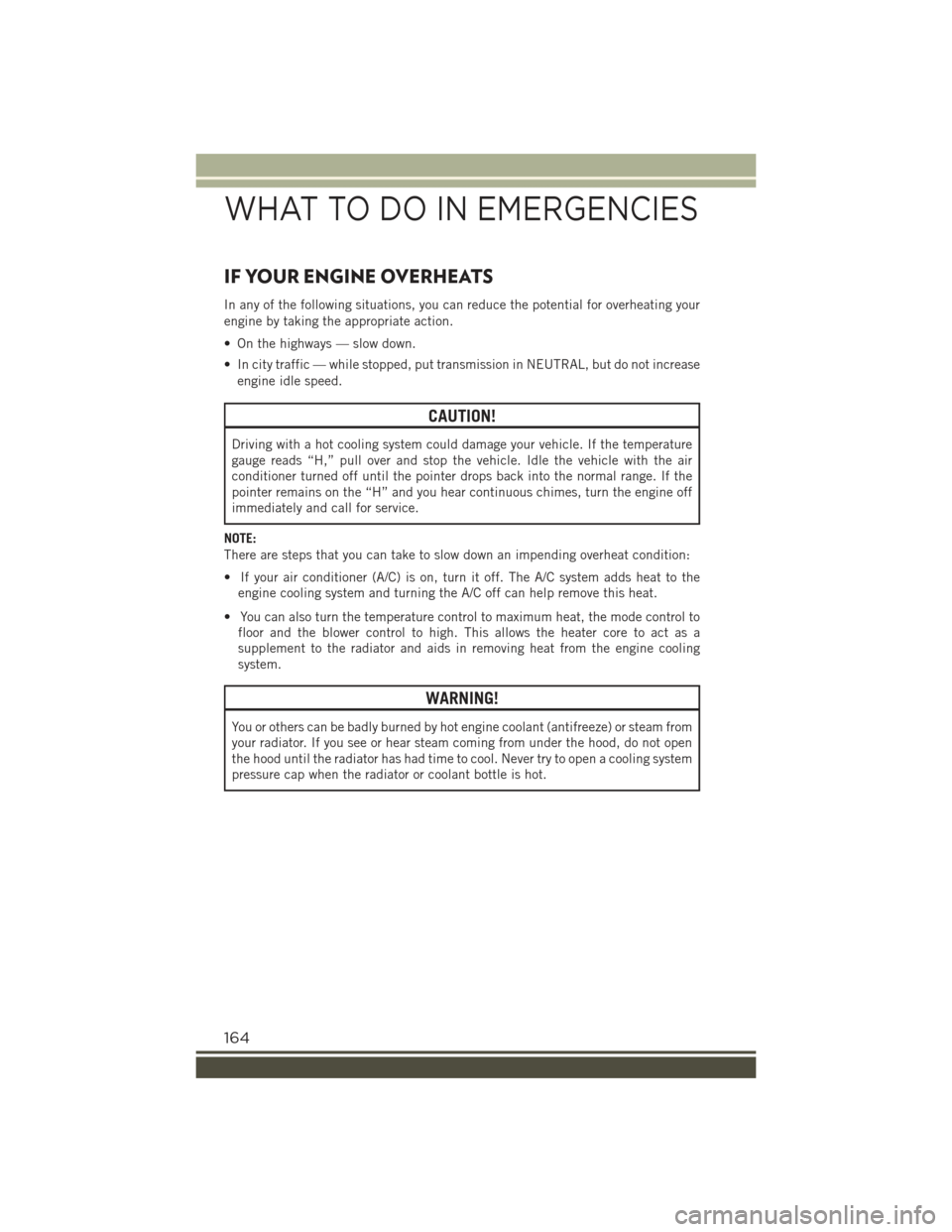
IF YOUR ENGINE OVERHEATS
In any of the following situations, you can reduce the potential for overheating your
engine by taking the appropriate action.
• On the highways — slow down.
• In city traffic — while stopped, put transmission in NEUTRAL, but do not increase
engine idle speed.
CAUTION!
Driving with a hot cooling system could damage your vehicle. If the temperature
gauge reads “H,” pull over and stop the vehicle. Idle the vehicle with the air
conditioner turned off until the pointer drops back into the normal range. If the
pointer remains on the “H” and you hear continuous chimes, turn the engine off
immediately and call for service.
NOTE:
There are steps that you can take to slow down an impending overheat condition:
• If your air conditioner (A/C) is on, turn it off. The A/C system adds heat to the
engine cooling system and turning the A/C off can help remove this heat.
• You can also turn the temperature control to maximum heat, the mode control to
floor and the blower control to high. This allows the heater core to act as a
supplement to the radiator and aids in removing heat from the engine cooling
system.
WARNING!
You or others can be badly burned by hot engine coolant (antifreeze) or steam from
your radiator. If you see or hear steam coming from under the hood, do not open
the hood until the radiator has had time to cool. Never try to open a cooling system
pressure cap when the radiator or coolant bottle is hot.
WHAT TO DO IN EMERGENCIES
164
Page 176 of 220
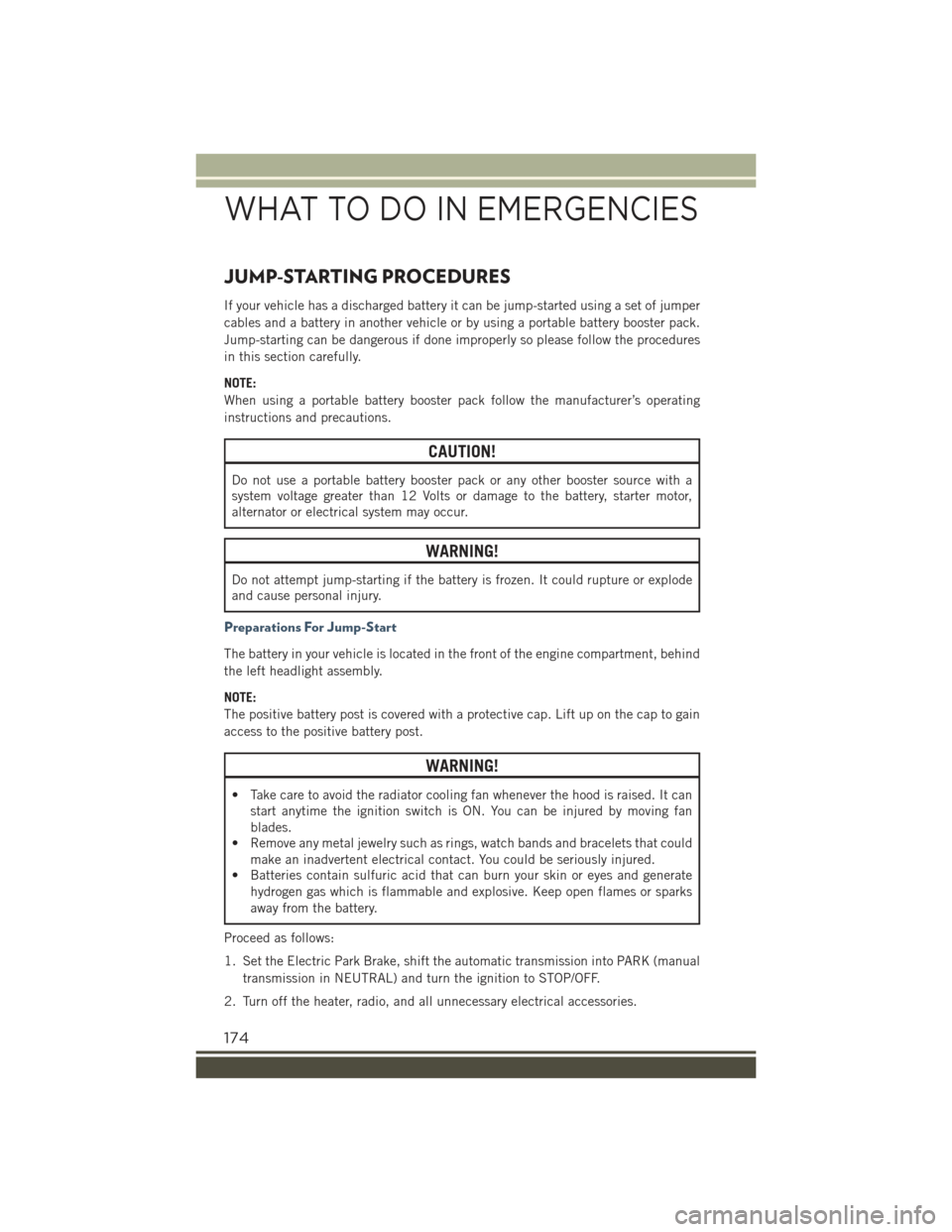
JUMP-STARTING PROCEDURES
If your vehicle has a discharged battery it can be jump-started using a set of jumper
cables and a battery in another vehicle or by using a portable battery booster pack.
Jump-starting can be dangerous if done improperly so please follow the procedures
in this section carefully.
NOTE:
When using a portable battery booster pack follow the manufacturer’s operating
instructions and precautions.
CAUTION!
Do not use a portable battery booster pack or any other booster source with a
system voltage greater than 12 Volts or damage to the battery, starter motor,
alternator or electrical system may occur.
WARNING!
Do not attempt jump-starting if the battery is frozen. It could rupture or explode
and cause personal injury.
Preparations For Jump-Start
The battery in your vehicle is located in the front of the engine compartment, behind
the left headlight assembly.
NOTE:
The positive battery post is covered with a protective cap. Lift up on the cap to gain
access to the positive battery post.
WARNING!
• Take care to avoid the radiator cooling fan whenever the hood is raised. It can
start anytime the ignition switch is ON. You can be injured by moving fan
blades.
• Remove any metal jewelry such as rings, watch bands and bracelets that could
make an inadvertent electrical contact. You could be seriously injured.
• Batteries contain sulfuric acid that can burn your skin or eyes and generate
hydrogen gas which is flammable and explosive. Keep open flames or sparks
away from the battery.
Proceed as follows:
1. Set the Electric Park Brake, shift the automatic transmission into PARK (manual
transmission in NEUTRAL) and turn the ignition to STOP/OFF.
2. Turn off the heater, radio, and all unnecessary electrical accessories.
WHAT TO DO IN EMERGENCIES
174
Page 188 of 220
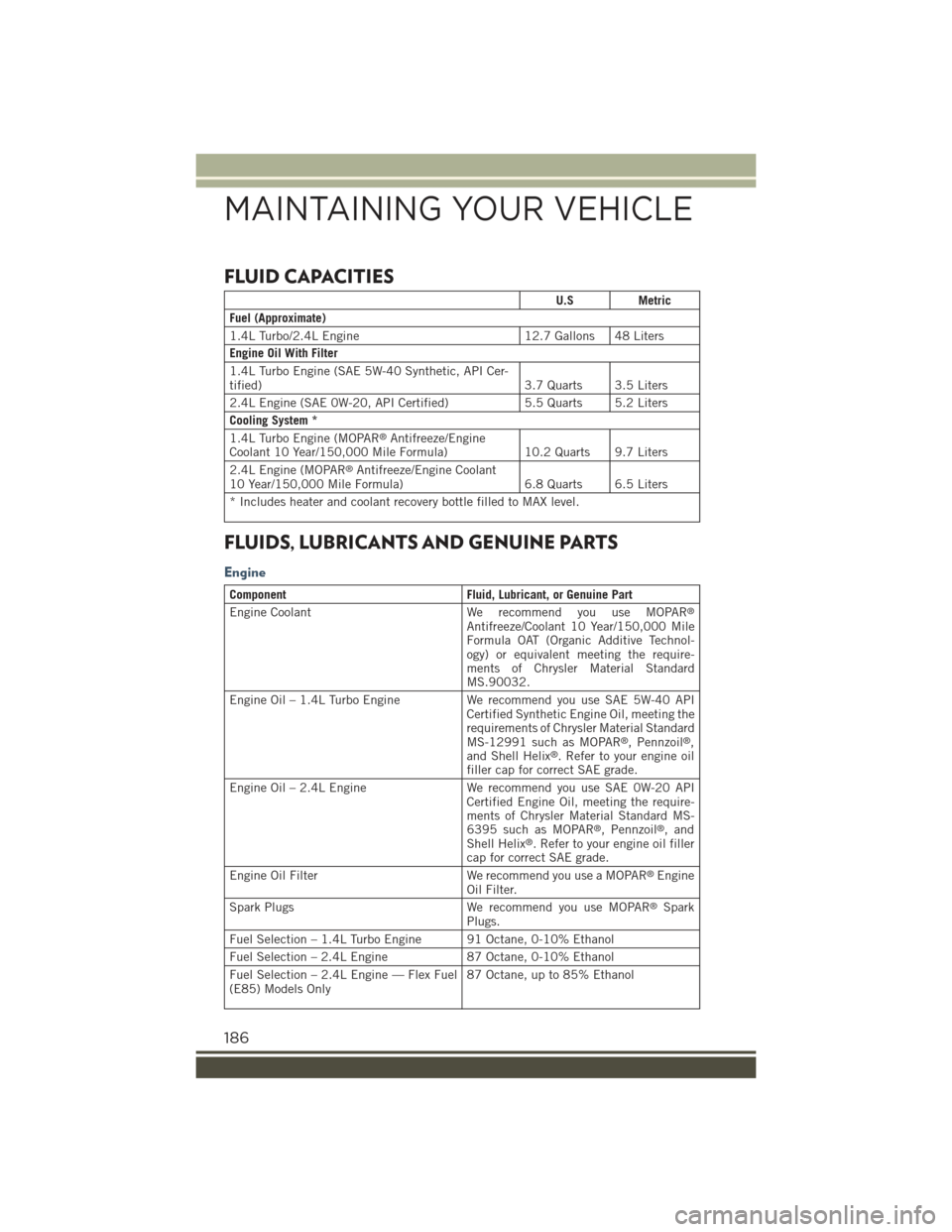
FLUID CAPACITIES
U.SMetric
Fuel (Approximate)
1.4L Turbo/2.4L Engine12.7 Gallons 48 Liters
Engine Oil With Filter
1.4L Turbo Engine (SAE 5W-40 Synthetic, API Cer-tified)3.7 Quarts 3.5 Liters
2.4L Engine (SAE 0W-20, API Certified)5.5 Quarts 5.2 Liters
Cooling System *
1.4L Turbo Engine (MOPAR®Antifreeze/EngineCoolant 10 Year/150,000 Mile Formula)10.2 Quarts 9.7 Liters
2.4L Engine (MOPAR®Antifreeze/Engine Coolant10 Year/150,000 Mile Formula) 6.8 Quarts 6.5 Liters
* Includes heater and coolant recovery bottle filled to MAX level.
FLUIDS, LUBRICANTS AND GENUINE PARTS
Engine
ComponentFluid, Lubricant, or Genuine Part
Engine CoolantWe recommend you use MOPAR®
Antifreeze/Coolant 10 Year/150,000 MileFormula OAT (Organic Additive Technol-ogy) or equivalent meeting the require-ments of Chrysler Material StandardMS.90032.
Engine Oil – 1.4L Turbo Engine We recommend you use SAE 5W-40 APICertified Synthetic Engine Oil, meeting therequirements of Chrysler Material StandardMS-12991 such as MOPAR®, Pennzoil®,and Shell Helix®. Refer to your engine oilfiller cap for correct SAE grade.
Engine Oil – 2.4L Engine We recommend you use SAE 0W-20 APICertified Engine Oil, meeting the require-ments of Chrysler Material Standard MS-6395 such as MOPAR®, Pennzoil®,andShell Helix®. Refer to your engine oil fillercap for correct SAE grade.
Engine Oil Filter We recommend you use a MOPAR®EngineOil Filter.
Spark Plugs We recommend you use MOPAR®SparkPlugs.
Fuel Selection – 1.4L Turbo Engine 91 Octane, 0-10% Ethanol
Fuel Selection – 2.4L Engine 87 Octane, 0-10% Ethanol
Fuel Selection – 2.4L Engine — Flex Fuel(E85) Models Only87 Octane, up to 85% Ethanol
MAINTAINING YOUR VEHICLE
186
Page 190 of 220
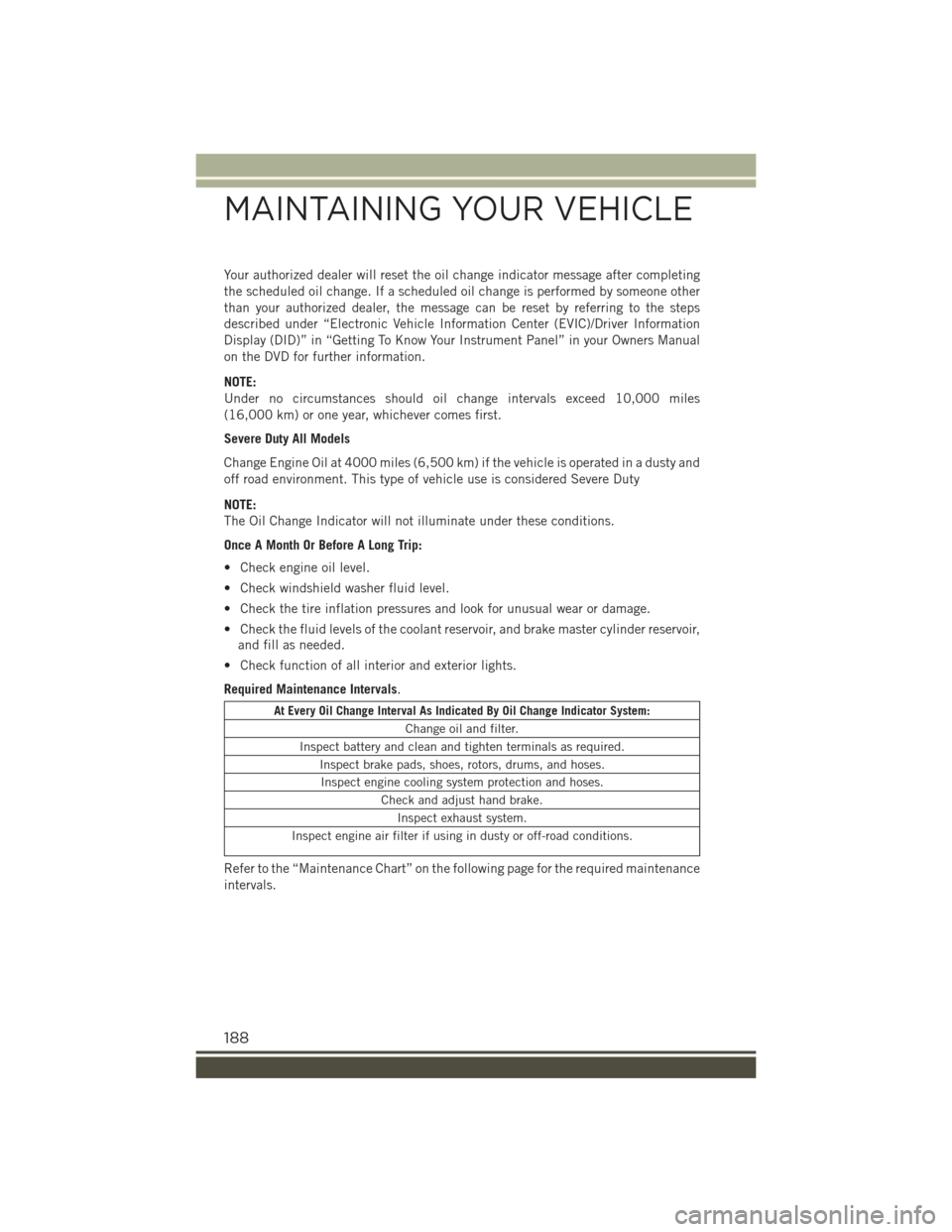
Your authorized dealer will reset the oil change indicator message after completing
the scheduled oil change. If a scheduled oil change is performed by someone other
than your authorized dealer, the message can be reset by referring to the steps
described under “Electronic Vehicle Information Center (EVIC)/Driver Information
Display (DID)” in “Getting To Know Your Instrument Panel” in your Owners Manual
on the DVD for further information.
NOTE:
Under no circumstances should oil change intervals exceed 10,000 miles
(16,000 km) or one year, whichever comes first.
Severe Duty All Models
Change Engine Oil at 4000 miles (6,500 km) if the vehicle is operated in a dusty and
off road environment. This type of vehicle use is considered Severe Duty
NOTE:
The Oil Change Indicator will not illuminate under these conditions.
Once A Month Or Before A Long Trip:
• Check engine oil level.
• Check windshield washer fluid level.
• Check the tire inflation pressures and look for unusual wear or damage.
• Check the fluid levels of the coolant reservoir, and brake master cylinder reservoir,
and fill as needed.
• Check function of all interior and exterior lights.
Required Maintenance Intervals.
At Every Oil Change Interval As Indicated By Oil Change Indicator System:
Change oil and filter.
Inspect battery and clean and tighten terminals as required.
Inspect brake pads, shoes, rotors, drums, and hoses.
Inspect engine cooling system protection and hoses.
Check and adjust hand brake.
Inspect exhaust system.
Inspect engine air filter if using in dusty or off-road conditions.
Refer to the “Maintenance Chart” on the following page for the required maintenance
intervals.
MAINTAINING YOUR VEHICLE
188
Page 197 of 220
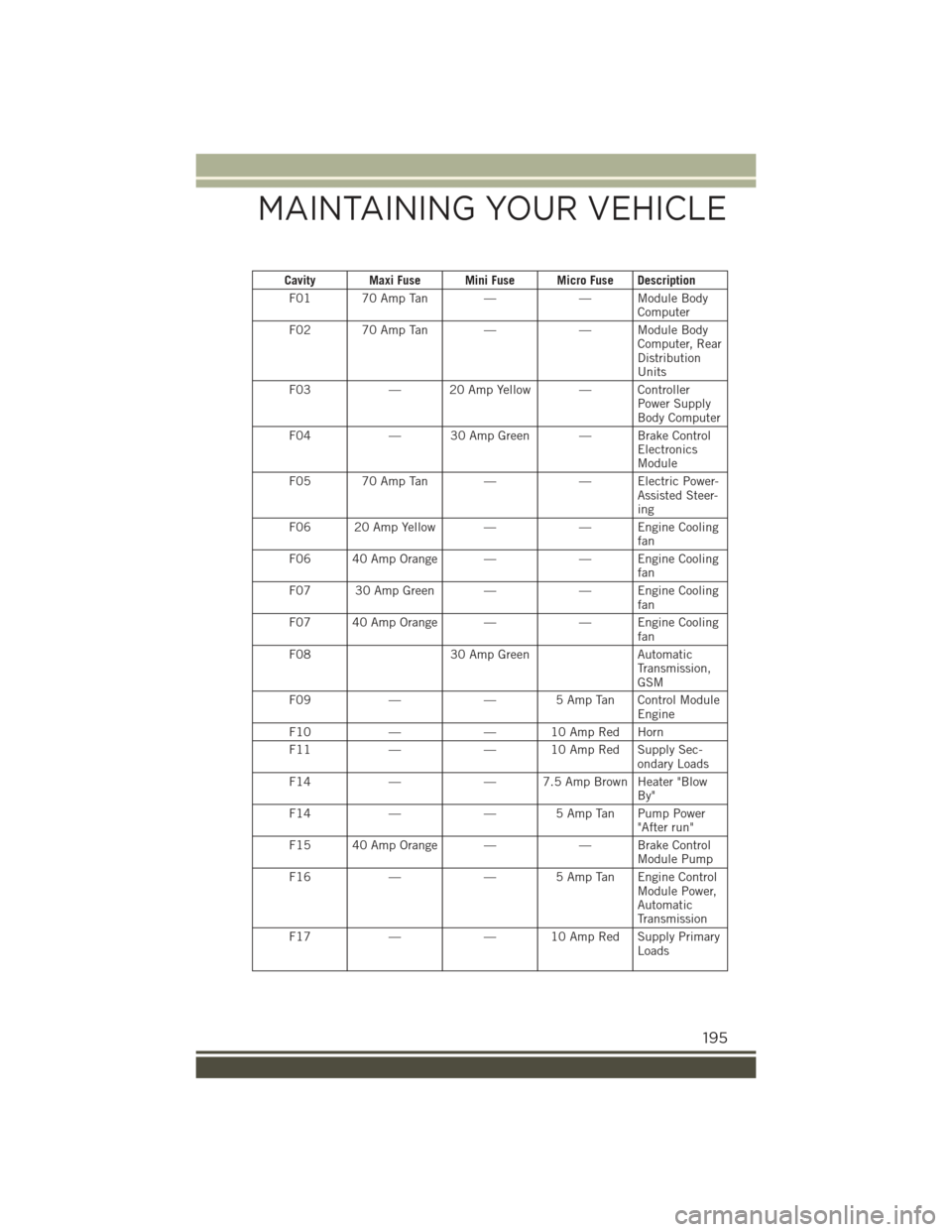
Cavity Maxi Fuse Mini Fuse Micro Fuse Description
F01 70 Amp Tan ——ModuleBodyComputer
F02 70 Amp Tan ——ModuleBodyComputer, RearDistributionUnits
F03— 20 Amp Yellow — ControllerPower SupplyBody Computer
F04— 30 Amp Green — Brake ControlElectronicsModule
F05 70 Amp Tan ——ElectricPower-Assisted Steer-ing
F06 20 Amp Yellow ——EngineCoolingfan
F06 40 Amp Orange ——EngineCoolingfan
F07 30 Amp Green ——EngineCoolingfan
F07 40 Amp Orange ——EngineCoolingfan
F0830 Amp GreenAutomaticTransmission,GSM
F09——5AmpTanControlModuleEngine
F10——10AmpRedHorn
F11——10AmpRedSupplySec-ondary Loads
F14——7.5AmpBrownHeater"BlowBy"
F14——5AmpTanPumpPower"After run"
F15 40 Amp Orange ——BrakeControlModule Pump
F16——5AmpTanEngineControlModule Power,AutomaticTransmission
F17——10AmpRedSupplyPrimaryLoads
MAINTAINING YOUR VEHICLE
195
Page 211 of 220
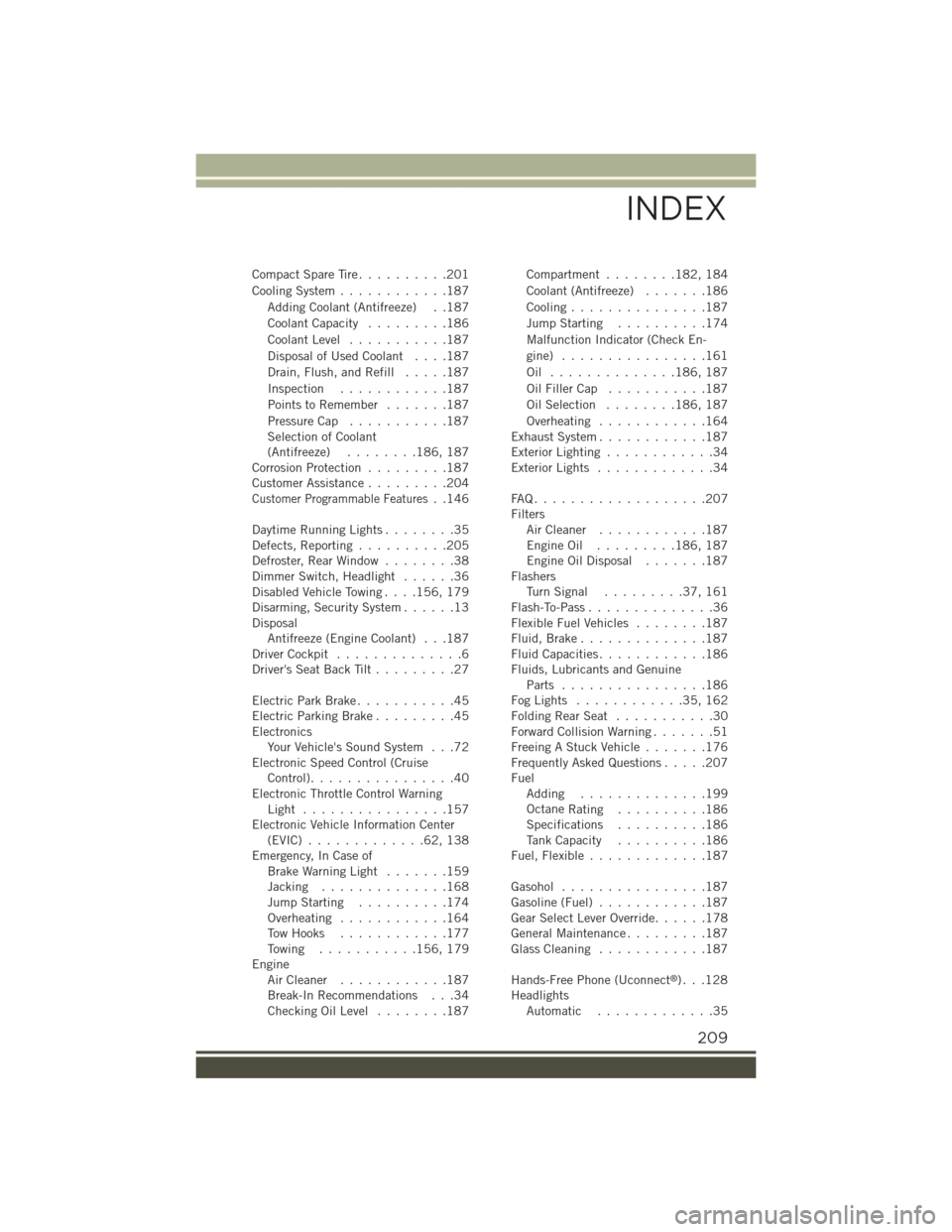
Compact Spare Tire..........201
Cooling System............187
Adding Coolant (Antifreeze) . .187
Coolant Capacity.........186
Coolant Level...........187
Disposal of Used Coolant....187
Drain, Flush, and Refill.....187
Inspection............187
Points to Remember . . . . . . .187
Pressure Cap...........187Selection of Coolant(Antifreeze)........186, 187Corrosion Protection.........187Customer Assistance.........204
Customer Programmable Features..146
Daytime Running Lights........35Defects, Reporting..........205Defroster, Rear Window........38Dimmer Switch, Headlight......36Disabled Vehicle Towing....156, 179Disarming, Security System......13DisposalAntifreeze (Engine Coolant) . . .187Driver Cockpit..............6Driver's Seat Back Tilt.........27
Electric Park Brake...........45Electric Parking Brake.........45ElectronicsYour Vehicle's Sound System . . .72Electronic Speed Control (CruiseControl)................40Electronic Throttle Control WarningLight . . . . . . . . . . . . . . . .157Electronic Vehicle Information Center(EVIC) . . . . . . . . . . . . .62, 138Emergency, In Case ofBrake Warning Light.......159Jacking..............168Jump Starting..........174Overheating............164Tow Hooks............177To w i n g . . . . . . . . . . .156, 179EngineAir Cleaner . . . . . . . . . . . .187Break-In Recommendations . . .34Checking Oil Level........187
Compartment........182, 184
Coolant (Antifreeze).......186
Cooling...............187
Jump Starting..........174
Malfunction Indicator (Check En-
gine) . . . . . . . . . . . . . . . .161
Oil . . . . . . . . . . . . . .186, 187
Oil Filler Cap...........187
Oil Selection........186, 187
Overheating............164Exhaust System............187Exterior Lighting............34Exterior Lights.............34
FA Q . . . . . . . . . . . . . . . . . . . 2 0 7FiltersAir Cleaner............187Engine Oil . . . . . . . . .186, 187Engine Oil Disposal.......187FlashersTu r n S i g n a l . . . . . . . . . 3 7 , 1 6 1Flash-To-Pass..............36Flexible Fuel Vehicles........187Fluid, Brake..............187Fluid Capacities............186Fluids, Lubricants and GenuineParts . . . . . . . . . . . . . . . .186Fog Lights . . . . . . . . . . . .35, 162Folding Rear Seat . . . . . . . . . . .30Forward Collision Warning.......51Freeing A Stuck Vehicle.......176Frequently Asked Questions.....207FuelAdding..............199OctaneRating..........186Specifications..........186Tank Capacity..........186Fuel, Flexible . . . . . . . . . . . . .187
Gasohol................187Gasoline (Fuel)............187Gear Select Lever Override......178General Maintenance.........187Glass Cleaning............187
Hands-Free Phone (Uconnect®). . .128HeadlightsAutomatic.............35
INDEX
209